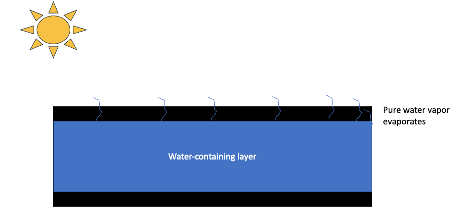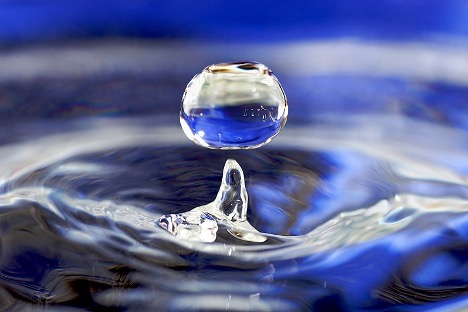Article Title: Bio-Inspired Sandwich-Structured All-Day-Round SolarEvaporator for Synergistic Clean Water and Electricity Generation
Authors: Ran Niu, Jiaxin Ren, Junqiang Justin Koh, Ling Chen, Jiang Gong,* Jinping Qu,Xiaodong Xu, Jalal Azadmanjiri, and Jiakang Min
Journal: Advanced Energy Materials
Year: 2023
DOI: https://doi.org/10.1002/aenm.202302451
Image Source: José Manuel Suárez
Solar evaporators are devices that use solar energy to purify water. These devices use sunlight to evaporate water, which may contain salts or other pollutants, into a pure vapor. That vapor can then be condensed into water that is drinkable or useful for agriculture. Ultimately these technologies could ensure water access where water is in short supply or is polluted.
This paper focuses on a type of solar evaporator called an interfacial evaporator (Figure 1). This design uses a sandwich structure where the water is stored in an inner layer and the top layer is heated by sunlight. Evaporation occurs at the interface between the layers. However, these devices only work intermittently because they rely on the presence of sunlight. They are not able to work as efficiently—or at all—during cloudy days or at night. Additionally, on hot days, some of the solar energy is lost as heat rather than being used to evaporate the water.

Figure 1: Sunlight heats the outer layer, causing the water to heat to its boiling point and evaporate as pure water vapor.
The researchers in this paper took inspiration from cold-weather beetles to improve their device. These beetles have evolved anti-freeze proteins to allow them to survive in very cold environments. Although these proteins evolved to protect against the cold, they have broad heat regulation effects that also apply in hot environments.

Figure 2: Microdera punctipennis beetles have enzymes that allow them to regulate their temperature in extreme environments. This temperature regulation was the inspiration for phase change microcapsules in this work (source)
The researchers mimicked the behavior of these proteins with a phase change microcapsule that they put in the middle layer, which was made of polyvinyl alcohol. The outer layers of the device were made of MnO2 embedded cotton cloth that converted sunlight into heat energy that evaporated the water in the inner layer. The phase change microcapsules in the inner layer release and absorb energy as they freeze and melt and help regulate the temperature, much like the beetle’s enzymes. To provide a use for the device at night, the researchers also added electronic components that could turn the inherent temperature gradient in the device into electricity. By essentially turning the devices into batteries, the researchers were able to heat up water at night without sunlight, further improving the devices’ efficiency.
Ultimately, the addition of a phase change material in the inner layer improved the efficiency of the evaporator 3.6 times compared to the same device with no phase change material. Additionally, the device was able to use its heat energy to produce electricity for 30 minutes after sunset. The researchers tested their system using salt water, lake water, and water artificially polluted with blue dyes. Each was purified using the device which was able to remove 99.9% of the dye. While not a commercially ready product, the research presented in this paper describes an important step forward in optimizing this technology and insuring safe and abundant water access where it is needed.

